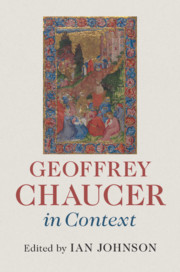Book contents
- Geoffrey Chaucer in Context
- Geoffrey Chaucer in Context
- Copyright page
- Contents
- Illustrations
- Contributors
- Abbreviations
- Introduction
- Part I Chaucer as Context
- Part II Books, Discourse and Traditions
- Part III Humans, the World and Beyond
- Part IV Culture, Learning and Disciplines
- Part V Political and Social Contexts
- Part VI Chaucer Traditions
- Further Reading
- Index
Part IV - Culture, Learning and Disciplines
Published online by Cambridge University Press: 24 June 2019
- Geoffrey Chaucer in Context
- Geoffrey Chaucer in Context
- Copyright page
- Contents
- Illustrations
- Contributors
- Abbreviations
- Introduction
- Part I Chaucer as Context
- Part II Books, Discourse and Traditions
- Part III Humans, the World and Beyond
- Part IV Culture, Learning and Disciplines
- Part V Political and Social Contexts
- Part VI Chaucer Traditions
- Further Reading
- Index
Summary
Chaucer lived in a society that was aware of childhood and adolescence as distinctive stages of human life and which inherited practices whereby young people were brought up and trained for adulthood. Informally, at home, children were introduced to social norms, religion and work. Those from wealthier families underwent more formal education, mastering literacy at home, in schools or in great households, where they learnt reading, rules of courtesy, French and, in the case of some boys, Latin. Chaucer’s works refer in passing to most of these processes, with particular attention to adolescents, including university scholars. During the fifteenth century his works in general came to be seen as having educational value. The Astrolabe, first written for his son Lewis, seems to have been used for teaching reading to other young children while his major writings were recommended as suitable literature for older ones.
Keywords
- Type
- Chapter
- Information
- Geoffrey Chaucer in Context , pp. 217 - 292Publisher: Cambridge University PressPrint publication year: 2019

